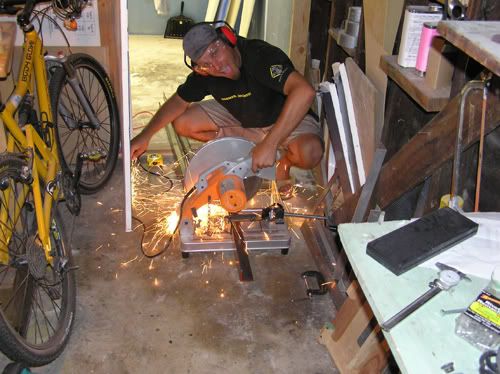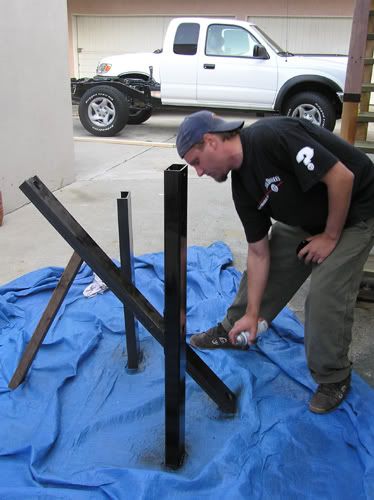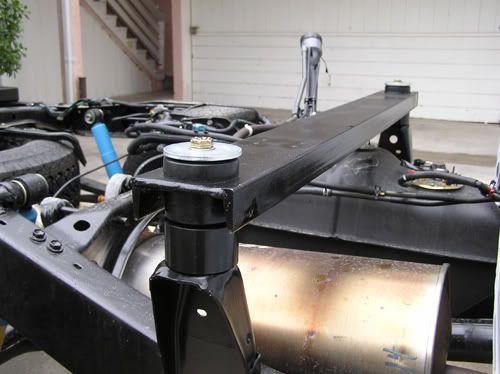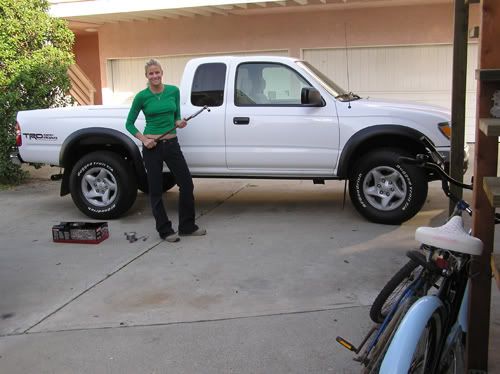
More than two years in the making, the Super Camper is finally approaching completion. Of course, we should have been updating a blog all along the way so that readers could follow along with our progress. I would have been able to point to a website as an answer every time I was asked, "how's the camper coming along?"
Alas, I was only alerted to the ease of blogging recently. So I figured, better late than never!
Above, you see the camper as it is in September 2006. Hopefully soon, this blog will be filled with stories of our journeys as we finally begin to take the camper on the road. In the meantime, if you are interested in how we got to this point, read along as we travel back in time to Spring 2004 when inspiration struck somewhere in Southwestern Australia... But first, I should introduce the characters.
Ryan Roelen is one of the most intelligent and talented people i've ever met. He shapes his own surfboards, grows his own chiles, and is an amazing cook. Unfortunately, he can't spend as many hours lurking in the garden as he would like. During the week he functions as a mechanical engineer at Robinson Helicopter Company in Torrance, CA.

Holly Beck (your narrator) is a professional surfer, earning a living by travelling the globe with her surfboard competing in international events, representing her sponsors (Body Glove http://www.bodyglove.com, Rusty surfboards http://www.rusty.com, Freestyle watches http://www.freestyleusa.com, Sector 9 skateboards http://www.sector9.com, and DaKine surfing accessories http://www.dakine.com) in the media as a spokesperson for women's surfing, and modelling. Photo: Aaron Checkwood, North Shore Oahu, December 2005
In Spring of 2004, I dragged Ryan along to a WQS surfing event in Margaret River, Western Australia. We rented a 4x4 camper-truck and hoped to camp overlooking the beach and surf uncrowded waves after the contest finished. Unfortunately (but happily for Ryan), the contest finished early for me, so we had plenty of extra days to explore. Contrary to our expectations, the Margaret River area featured more concrete and hook-up campgrounds than wild areas, although we did find one natural campsite in a beautiful forrest.
The camper was reasonably comfortable and performed very well on the deep sand access roads to some of the more remote beaches, but certainly had a few design flaws. At some point Ryan suggested we look into buying one at home, but also mentioned he might be capable of making something like this, only better. Either idea sounded pretty good to me!
After browsing the internet's "camper for sale" listings and coming up empty, I encouraged Ryan to follow through on his claim that we could just make it ourselves. Many people along the way would ask, "why didn't you just buy one?" The answer to that is pretty simple. First, the majority of campers for 4x4 trucks on the market are the type that slide into the bed of the truck like these:
This design requires the camper to be more narrow than it could be since it has to fit inside the bed (or inside the trunk in the second photo), and they also end up being heavier since the bed itself is still on there. We decided that by removing the bed and building the camper directly on the frame of the truck, we could gain space and save weight. We did find find some campers for sale online (like the EarthRoamer http://www.earthroamer.com
The first step was designing what would come to be called The Super Camper. Ryan put his mechanical engineering skills to use, spending several months coming up with the concept and design. It was all completely custom. We sat on chairs and discussed the ideal height for the benches. We designed the ceiling to be just tall enough for us to stand tall inside and not bump our heads, and the benches to be just long enough for us to stretch out on comfortably. We discussed the best place to store our surfboards and wetsuits.
We decided that we would use a Toyota Tacoma 4x4 truck as the base of the camper and had to run around the neighborhood to find Tacomas to check out in order to try to see what the frame looked like so that Ryan could design the way the camper would mount to the frame. The next step was to actually go out and purchase the truck. With the help of my friend Stuart Hoshide and the good people at South Bay Toyota (http://www.southbaytoyota.com), we got a great deal on a brand new 2004 Toyota Tacoma 4x4 with the offroad package.
Then it came time to try to figure out how to remove the bed of the truck.
Here is Ryan and his friend "the Butchman" working on removing the bed.
With the bed gone, we had a much better view of the frame of the truck and could finally decide on the best way to connect the camper to the frame. You might be wondering what we did with it. The bed is safely stored away in the garage. We plan to sell it at some point, but only after we have taken the camper on a few trips and are sure that we don't ever want to go back to having a normal truck.
Ryan used 2"x4"s to help visualize the best way to design the mounts. It made me a little nervous to be drilling into the frame of our brand new truck, but I had faith in the Super Engineer.
Ryan used a saw purchased from Harbor Freight (http://www.harborfreight.com) to cut the steel angles for the frame. He was very excited about the sparks flying everywhere!
In order to prevent rust, the steel pieces were then sprayed with Rustoleum. 
The front mount is solid and stable, 
while the back mount is able to pivot, in order to allow the frame to flex while travelling over rough terrain without cracking the camper.

This is a shot looking into the hollow center of the back mount. You can see the rubber spacer that allows the mount to flex.
During our research online we came across a product called Nidacore (http://www.nida-core.com) that seemed perfect to use as the structure of the camper. 
The Nidacore product we chose came in 4'x8' sheets of 1 1/4" polypropylene honeycomb sandwiched with fiberglass. It is lightweight and incredibly strong. As a bonus, we would use fiberglass and resin to attach the pieces together, which due to our surfing background, are familiar materials. Here I am copying a photo from the EarthRoamer's website, demonstrating the strength of a sheet of Nidacore.
We are now ready to start sawing pieces of NidaCore. Check out the following blog updates for the construction process....










6 comments:
Hi Ryan and Holly,
This supercamper documentary is really amazing, in a way. It's informative useful stuff. I thank you all. But part of me wonders: why did you do this? I guess it's just a thing to do if you have the time and the entourage of support from people who care.
This is my first direct exposure to the blogging world.
I live in Ocean Beach and surf around San Diego.
Scott
Sweet! I've been looking into this for some time now and although I would love to buy something like this, 200k plus for the Earthroamer is just a tad pricey. Do you have any more pics? What about the interior?
I've been considering this for some time for my Nissan Titan.
As a fellow ME I must say this,
ME's rule!
Would love to check out your creation.
Drago
Just stumbled across this blog. I've been toying with the idea of building my own camper since seeing the Turtle Expedition buildup in a four wheel magazine years ago. They also used the Nida-Core but had it done professionally. You give me hope that it is accessible to the DIYer with a reasonable amount of talent. Have to read through the whole story, but maybe this will finally motivate me to get started!
Fantastic job on the camper! You two are a beautiful couple! God Bless you both!
Do you guys swing? ~dngl
The heck with swinging. Do you fool around Holly?
Earle E.
Post a Comment